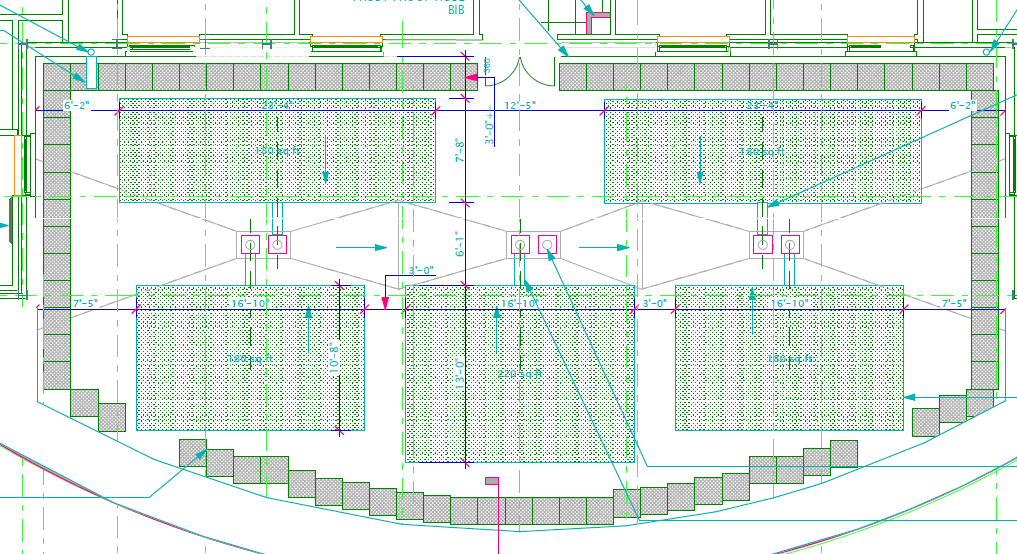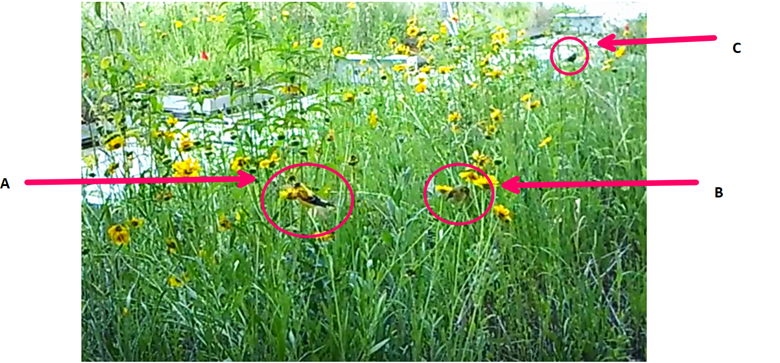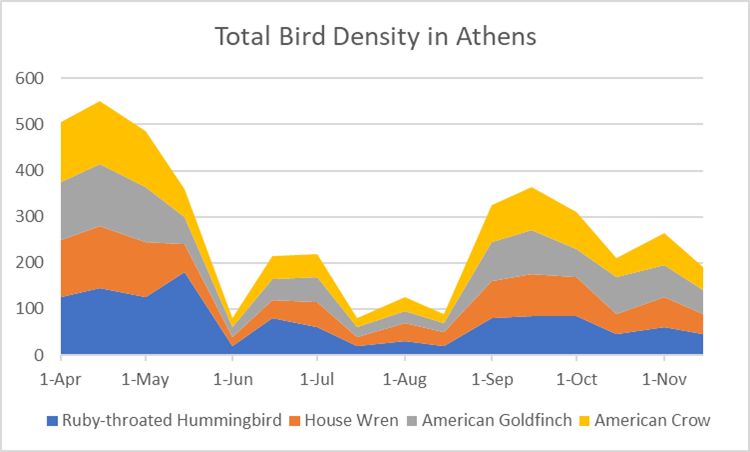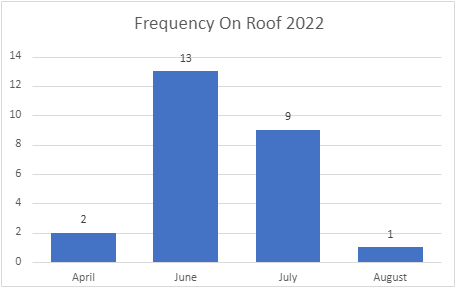
Bird Habitat
This is a report by Nathan Byrd, an undergraduate research student who conducted a study of bird activity on the green roof, under the supervision of Dr. Kim Thompson.
Introduction
As urbanization increases in cities and college towns across the U.S. there is less space for native wildlife, even when small patches of land are allocated for creating green spaces. Green spaces are often artificially constructed areas that include grasses, trees, and decorative plants, not necessarily native to the area. If these spaces include a diverse set of native plants, they can be excellent spaces for animals to convene for food and shelter and will increase biodiversity (Wang et al. 2017).
Another option for expanding habitat in an urbanized area is by investing in green roofs (Fernandez-Canero & Gonzalez-Redondo 2010; Partridge & Clark 2018). Like other green spaces, green roofs provide a permeable surface covered with vegetation. Green infrastructure, including green roofs, is a system that offsets rainwater strain on public sewage systems and reduces pollution entering streams (e.g. Akther et al. 2018). Green (vegetated) rooftops are also able to keep buildings cooler in the summer, reducing energy costs and extending the life of the roof by decreasing heat stress and protecting the membrane from UV radiation (e.g. Blackhurst 2010, U.S. General Services Administration 2011).
Ohio University’s Schoonover Center Green Roof was installed for research and education on benefits of living rooftops. In this study, we used a green roof that is on the third story of Schoonover Center with five separate planter beds for a total of 960 square feet of vegetation. It is important to note that not every green roof needs to be high off the ground to be considered a green roof. For example, Millennium Park in Chicago, covering a parking garage, is a green roof (Greenroofs.com 2022). It had to be carefully designed to protect the integrity of the underlying structure.
Green roofs can provide a safe space for birds and other organisms (Bryce 2016) although the size of the green roof can affect activity (Partridge & Clark 2022). Most terrestrial predators are unable to reach a green roof, making green roofs a viable location for nesting birds, though some predators to bird species are other birds. There were no signs or observations of these predatory birds utilizing the Schoonover green roof. Besides providing a location for shelter, green roofs can also be a great spot for accessing food and water.
When native species of plants are used on a green roof, they are more likely to draw local and migrating species of birds, depending on the time of year. Migrating birds can utilize the seeds on roofs to refill fat reserves so they can continue their journey. Birds that are insectivores are also more common on green roofs (Partridge & Clark 2018). The primary diet of insectivores consists of insects or arthropods, and these are commonly found on green roofs (Fernandez-Canero & Gonzalez-Redondo 2010), including Schoonover Center (unpublished data 2021-2023).
The goal of this study was to evaluate whether the Schoonover Center Green Roof in Athens, Ohio attracts bird species. While attracting birds to this space was not the original intention of the installation, it is still important to investigate the potential effects of the green roof as habitat to better understand the range of benefits provided by this type of green infrastructure.
Methods
Bird visits were monitored on a green roof, located in Athens Ohio, at Ohio University’s Schoonover Center. The Schoonover Green Roof is a small rooftop on a third story. located just outside the School of Media Arts and Studies, Scripps College of Communication. There is a total of 960 square feet of vegetation spread across five separate constructed beds with engineered, lightweight soil (Figure 1). These were seeded with a mix of native meadow plants when the green roof was installed in July 2020 and plants were established within a month with regular irrigation. The windows on the green roof were covered with Bird Film to absorb UV light and prevent reflection of the plants. This is a deterrent to bird collisions with the window (Klem 2009).
Recordings of the roof were collected between April 2022 and April 2023 using a motion-activated Browning Game Camera set for 30 second videos with a 3-minute interval. The footage was captured on an SD card and reviewed from January through April 2023. During this period, gaps in the record did occur due to the unpredictability of the battery lifespan of the game camera. The camera's location was set to monitor activity on one of the beds where birds had been informally observed before this study. The view was limited and had blind spots which obstructed the view of birds visiting other beds on the green roof. An external hard drive was used to store and review the videos during this period.
Each of the 30 sec. video recordings were checked and tracked for bird activity weekly throughout the study period. Although the camera was set to motion activation with high sensitivity, numerous videos resulted in no bird activity. Each recording where activity was spotted was labeled with the observed activity, such as seed eating, and the bird species was identified, if possible, using iNaturalist (2023) and behaviors and food sources were researched using Audubon (2023a, 2023b) and All About Birds, Cornell Lab of Ornithology (2023). All. The camera footage includes time and temperature for each recording.
All work on the monitoring of birds on Schoonover was approved by IACUC.
Results
From April 2022-April 2023, there were 25 instances of bird sightings captured by the game camera, with four distinct species of birds spotted. The observed activities include eating from the native plants, sheltering in the plants from other birds, and drinking water that pooled around drains on the roof (Table 1, Figure 2). There were additional research projects being conducted on the green roof during the study period, with regular visits from student researchers and work in the surveyed bed, which seemed to have led to a decline in visits by birds (Kim Thompson, personal observations). For comparison, data on the activity of bird species in Athens, Ohio were downloaded from eBird for 2022 (Athens OH 2023), but only for the birds that had been spotted on the Schoonover Green Roof (Figure 3). The only months where bird activity was detected on Schoonover were April, June, July and August (Figure 4).

Figure 1: The Schoonover Center Green Roof design. Each of the 5 green boxes represent the planter beds. The game camera is located in the top right hand corner on this image.

Figure 2: Image captured with the game camera on the Schoonover Green Roof on June 4, 2022 at 7:14am. Circled are three birds, American Goldfinch (A), another finch or house wren (B) and an unknown species (C). The first is perched on Rudbeckia hirta, a native perennial with yellow flowers.
Table 1: Total data from the game camera as well as external weather measurements (Weather Underground 2022). All bird interactions, species, and number of birds spotted in each video are recorded in the table.
| Date | Time | Species | Weather | Temperature, °F. | Observation |
|---|---|---|---|---|---|
| 4/23/22 | 12:02 PM | Unknown small dark | Sunny 87F | 83 | fly by |
| 4/24/22 | 5:41 AM | Possible: Crow | Cloudy/ 60F | 59 | landed on plants |
| 6/1/22 | 7:17 AM | Goldfinch | Clear/71F | 62 | Chasing each other |
| 6/4/22 | 7:15 PM | Goldfinch | Sunny/ 59F | 78 | landed on plants |
| 6/4/22 | 7:14 AM | Goldfinch, Small black/possible Grackle | Sunny/ 59F | 62 | Landed on plants |
| 6/7/22 | 3:37 PM | Ruby-throated hummingbird | Cloudy/ 87F | 87 | fly by |
| 6/8/22 | 2:01 PM | Ruby-throated hummingbird | Sunny/ 102F | 86 | fly by |
| 6/16/22 | 12:17 PM | Goldfinch | Sunny/ 102F | 83 | landed on plants |
| 6/17/22 | 11:26 AM | Possible: House Wren | Sunny/ 98F | 82 | Eating from plant |
| 6/17/22 | 3:33 PM | Possible: House Wren | Sunny/ 122F | 86 | Running across membrane |
| 6/17/22 | 11:23 AM | Possible: Northern Mockingbird | Sunny/ 100F | 83 | landed on plants/ stayed 20 min |
| 6/18/22 | 6:51 AM | Goldfinch | Clear/ 66F | 62 | Eating from plants/ duration 5 min |
| 6/18/22 | 10:22AM | Goldfinch | Sunny/ 71F | 67 | landed on plants |
| 6/18/22 | 1:37 PM | Possible: House Wren | Sunny/ 100F | 74 | Running across membrane |
| 6/18/22 | 8:45 AM | Goldfinch:3 | Sunny/ 66F | 61 | landed on plants |
| 7/10/22 | 4:45 PM | Goldfinch | Sunny/ 131F | 85 | fly by |
| 7/10/22 | 10:30 AM | Goldfinch | Sunny/ 82 F | 81 | rested on plant |
| 7/10/22 | 10:45 AM | Goldfinch | Sunny/ 82F | 81 | eating from plants |
| 7/10/22 | 10:31AM | Possible: Goldfinch | Sunny/ 84F | 81 | landed on plants/ ran across membrane |
| 7/10/22 | 10:34 AM | Goldfinch | Sunny/ 84F | 81 | landed on plants |
| 7/10/22 | 10:56 AM | Goldfinch | Sunny/ 84F | 81 | fly by |
| 7/11/22 | 2:41 PM | Unknown | Sunny/ 123F | 88 | fly by |
| 7/13/22 | 10:19 AM | Goldfinch | Sunny/ 80F | 79 | Eating from plants |
| 7/13/22 | 10:01 AM | Goldfinch | Sunny/ 75F | 79 | Eating from plants/around 20 min |
| 8/9/22 | 1:23 PM | Unknown: tan/ black small | Sunny/ 100F | 78 | fly by |

Figure 3: The above figure represents the density (total number of birds counted in a region) of bird species spotted. This data was collected by local residents of Athens, Ohio in 2022. This data was recorded on the website eBirds.org. Only four species of birds are represented on this graph since these were the only species to be identified on the green roof.

Figure 4: The frequency (number on instants a bird species’ is counted) of birds visiting the Schoonover Green Roof throughout 2022. Only Apr. Jun. Jul. and Aug. are represented since these are the only months birds were spotted on the green roof. The green roof was monitored from Apr. through Dec. However, only the months represented above showed birds visiting the green roof.
Discussion
After 12 months of monitoring for birds on the Schoonover Center Green roof, there were 25 instances of bird activity. Only four species of birds were spotted utilizing the space.
Birds may have been attracted to the green roof due to the flowering native plants or water that sometimes collected around the drains on the roof. The majority of plant species flourished from late spring (April) to late fall (October). During the period in which the native plants were in their growth and flowering period, birds were observed utilizing the plants for food and temporary shelter. In addition to plant life, arthropods were also found to be present on the green roof in the planter beds. The arthropods added to the thriving artificial ecosystem created on the roof. They appeared to be a food source for a few of the observed bird species but this was not evaluated and the camera footage was too grainy to detect consumption of specific food sources.
The most spotted bird on the green roof was the American Goldfinch but the House Wren, Red-bellied Hummingbird, and American Crow were also spotted utilizing this space. There are a total of 16 American Goldfinch observations, a total of over 59% of the total birds spotted on the roof (Table 1). The main actions observed by the birds include drinking from rainwater that collected on the roof, eating from plants, and chasing other birds on the roof. On average the birds would visit the roof around 11 am each day. The average temperature was 75 degrees Fahrenheit and the bed they visited was the most shaded spot on the roof in the morning. The highest visit frequency was in June with nine recorded instances (Figure 4). This data is only meant to show correlations to bird visits.
When comparing the bird population density in Athens to the frequency of birds on the Schoonover Center green roof, a potential discrepancy was noted. There is a dip in reports of bird spotting in Athens between June and July for the birds we observed (Figure 3) but those months had the highest frequency of visit on the Schoonover Green Roof (Figure 4). To further explore this discrepancy, we investigated the migratory patterns of these birds. The only species out of the four birds that were identified exhibiting migratory patterns is the American Goldfinch. However, this species migrates in early winter and late spring (Audubon 2023a) so this behavior would not account for the discrepancy. All data collected for Figure 3 was conducted through community members reporting their findings. The difference may simply be due to a focus on citizen reporting during spring and winter. The American Goldfinch has the most diverse diet of the four birds we identified since they eat arthropods, seeds, and berries (Audubon 2023a) and at least two of these food sources are found on the Schoonover Green Roof.
The Schoonover Center green roof in Athens, Ohio seems to have provided a safe space for multiple bird species. While the intention of this green roof and many others is to provide a permeable surface to offset rainwater from local sewage systems and prevent flooding, it provides the added benefit of increased habitat in urbanized areas. More research and observations on this green roof over a few years will help us better understand whether this green roof provides habitat for a variety of bird species. For other green roofs, it can take five years or more to see activity from local bird populations (Bryce 2016). The biggest limitation of this study is the human activity that occurred on the green roof for other research projects during the time of our bird monitoring.
The recording equipment used in this study may have also been flawed in capturing all bird interactions on the green roof. The game camera was not continuously recording and would instead be activated by motion. There were likely many instances in which birds could quickly move past the camera before it began recording activity. Blind spots were also an issue with the placement of the camera and additional cameras over other beds would reveal a better picture of the green roof as habitat. The camera also had a limited battery life which resulted in holes during the data collection period.
The diversity of native plants present on the green roof could play a role in the bird species present on the roof (Wang et al. 2017). Other studies on the Schoonover Green Roof are evaluating plant diversity and this data may provide insight as to why certain bird species are more drawn than others. Arthropod diversity is also being studied and the results of those surveys may help explain the habitat potential of the green roof for birds.
References
Akther, M., He, J., Chu, A., Huang, J., & Van Duin, B. (2018). A review of green roof applications for managing urban stormwater in different climatic zones. Sustainability, 10:2864–2891.
All About Birds, Cornell Lab of Ornithology (2023). Ruby-throated hummingbird overview, all about birds, Cornell Lab of Ornithology. Overview, http://www.allaboutbirds.org/guide/Ruby-throated_Hummingbird/overview&n…;
Athens, OH, US - ebird. (2023). https://ebird.org/region/US-OH-009
Audubon (2023a). American goldfinch. https://www.audubon.org/field-guide/bird/american-goldfinch.
Audubon. (2023b). Ruby-throated hummingbird. https://www.audubon.org/field-guide/bird/ruby-throated-hummingbird.
Blackhurst, M., Hendrickson, C., & Matthews, H. S. (2010). Cost-effectiveness of green roofs. Journal of Architectural Engineering, 16(4), 136–143.
Bryce, E. (2016). Roofing revolution: How (gorgeous) green roofs benefit birds. Audubon. http://www.audubon.org/news/roofing-revolution-how-gorgeous-green-roofs-benefit-birds.
Fernandez-Canero, R., and P. Gonzalez-Redondo (2010). Green roofs as a habitat for birds: A Review. Journal of Animal and Veterinary Advances, 9 (15), 2041–2052. https://doi.org/10.3923/javaa.2010.2041.2052
Greenroofs.com. (2022, March 24). Millennium Park. http://www.greenroofs.com/projects/millennium-park/
iNaturalist (2023.). Athens County, US, OH. http://www.inaturalist.org/places/athens-county
Klem Jr, D. (2009). Preventing bird–window collisions. The Wilson Journal of Ornithology, 121(2), 314–321. https://doi.org/10.1676/08-118.1
Partridge, D. R., & Clark, J. A. (2018). Urban Green roofs provide habitat for migrating and breeding birds and their arthropod prey. PLOS ONE, 13(8). https://doi.org/10.1371/journal.pone.0202298.>
Partridge, D. R., & Clark, J. A. (2022). Small urban green roof plots near larger green spaces may not provide additional habitat for birds. Frontiers in Ecology and Evolution, 10. https://doi.org/10.3389/fevo.2022.779005.
U.S. General Services Administration (2011) The Benefits and Challenges of Green Roofs on Public and Commercial Buildings. U.S. Government Printing Office, Washington, DC. https://www.gsa.gov/cdnstatic/The_Benefits_and_Challenges_of_Green_Roofs_on_Public_and_Commercial_Buildings.pdf
Wang, J. W., Poh, C. H., Tan, C. Y., Lee, V. N., Jain, A., & Webb, E. L. (2017). Building Biodiversity: Drivers of Bird and butterfly diversity on Tropical Urban Roof Gardens. Ecosphere, 8(9). https://doi.org/10.1002/ecs2.1905.
Weather Underground. (2023). Athens, oh weather historystar_ratehome. http://www.wunderground.com/history/daily/us/oh/athens/date/2020-7-13